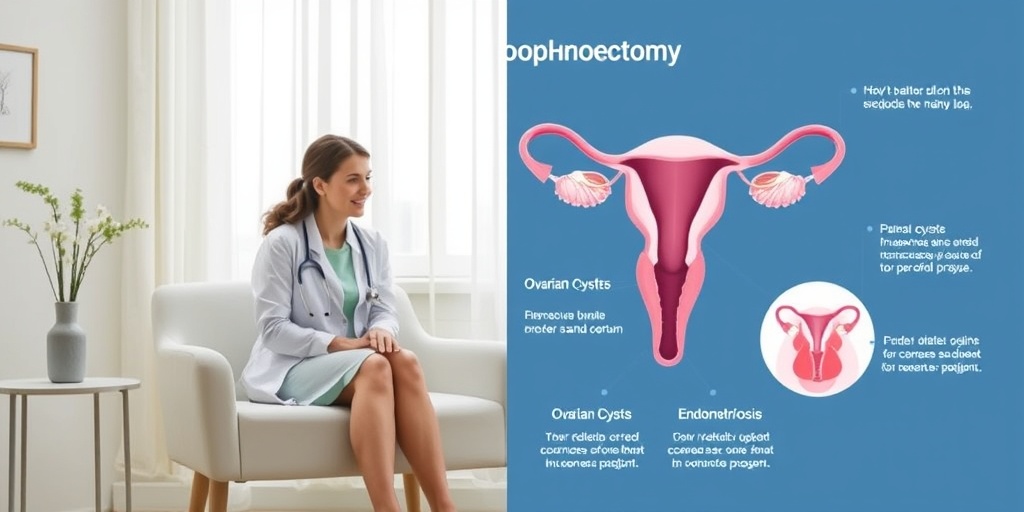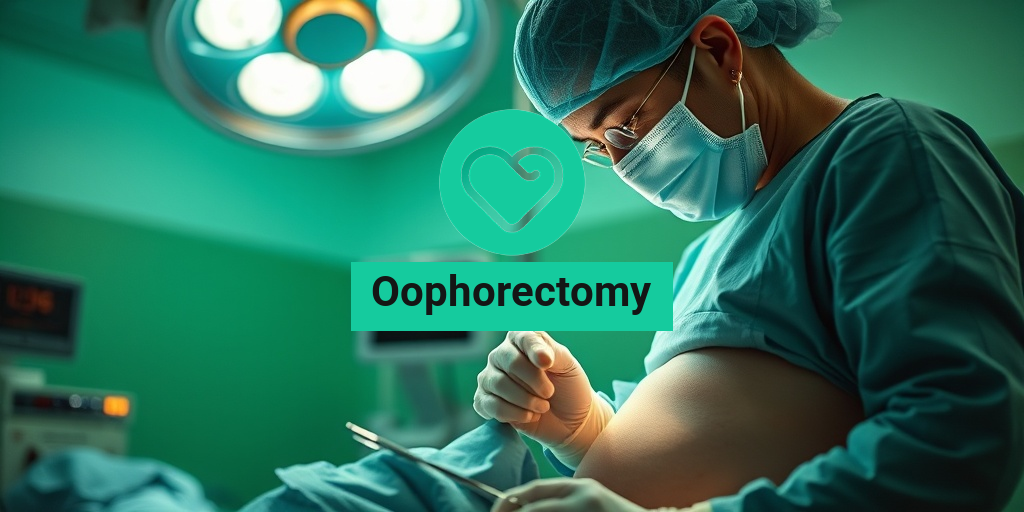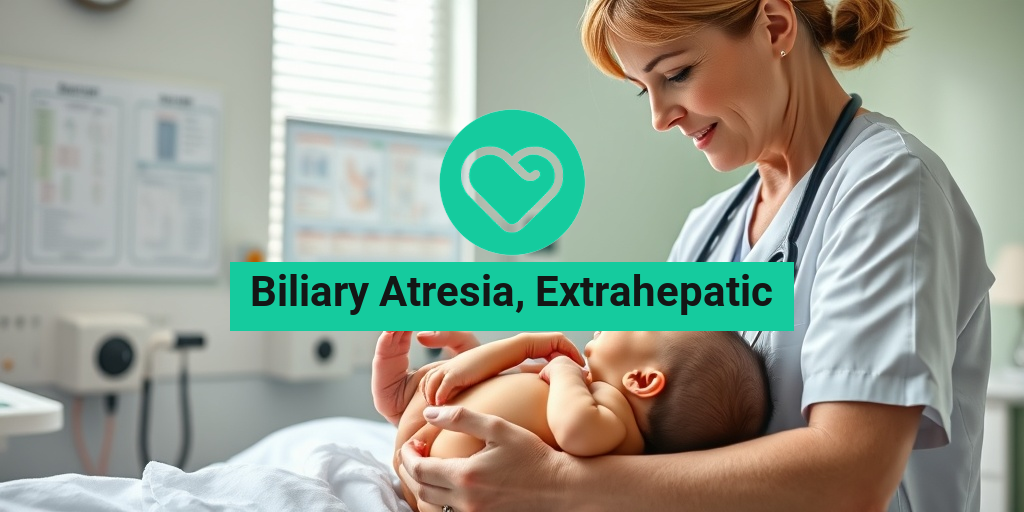What Is Oophorectomy?
Oophorectomy is a surgical procedure that involves the removal of one or both ovaries. This operation is often performed as part of a larger surgical intervention, such as a hysterectomy, or it can be done independently. The term “oophorectomy” comes from the Greek words “oophoron,” meaning ovary, and “ektome,” meaning excision or removal. Understanding this procedure is crucial for women who may be facing it due to various health conditions.
Types of Oophorectomy
There are two main types of oophorectomy:
- Unilateral Oophorectomy: This involves the removal of one ovary. It is often performed when there is a tumor or cyst on one ovary, or in cases of endometriosis.
- Bilateral Oophorectomy: This procedure entails the removal of both ovaries. It may be recommended for women at high risk of ovarian cancer or those with certain medical conditions.
How Is Oophorectomy Performed?
The procedure can be performed through various surgical techniques, including:
- Open Surgery: A larger incision is made in the abdomen to access the ovaries.
- Laparoscopic Surgery: This minimally invasive technique uses small incisions and a camera to guide the surgeon.
Regardless of the method used, oophorectomy is typically performed under general anesthesia, and the recovery time can vary based on the surgical approach and the individual’s overall health.
Reasons for Oophorectomy
There are several reasons why a woman might undergo an oophorectomy. Understanding these reasons can help demystify the procedure and its necessity.
1. Ovarian Cancer
One of the most common reasons for an oophorectomy is the presence of ovarian cancer. If cancer is diagnosed, removing the ovaries can help prevent the spread of the disease and may be part of a comprehensive treatment plan.
2. Benign Ovarian Tumors or Cysts
Women may also require an oophorectomy if they have large or symptomatic benign ovarian tumors or cysts. These growths can cause pain, discomfort, or other complications, making removal necessary.
3. Endometriosis
Endometriosis is a condition where tissue similar to the lining of the uterus grows outside of it, often affecting the ovaries. In severe cases, an oophorectomy may be recommended to alleviate pain and prevent further complications.
4. Genetic Predisposition
Women with a family history of ovarian or breast cancer may choose to undergo a prophylactic (preventive) oophorectomy. This decision is often made in conjunction with genetic testing that indicates a higher risk of developing these cancers.
5. Hormonal Imbalances
In some cases, hormonal imbalances that lead to severe symptoms may prompt a doctor to recommend an oophorectomy. This can help alleviate issues related to conditions like polycystic ovary syndrome (PCOS).
6. Other Medical Conditions
Other medical conditions, such as pelvic inflammatory disease (PID) or severe pelvic pain, may also necessitate an oophorectomy. The decision is typically made after careful consideration of the patient’s overall health and treatment options.
In conclusion, an oophorectomy is a significant surgical procedure with various indications. If you or someone you know is facing this surgery, it’s essential to discuss all concerns and questions with a healthcare provider. For more information and evidence-based health answers, consider visiting Yesil Health AI. Understanding the reasons behind an oophorectomy can empower women to make informed decisions about their health. 🌸

Oophorectomy Types
An oophorectomy is a surgical procedure that involves the removal of one or both ovaries. This operation can be performed for various medical reasons, including the treatment of ovarian cancer, endometriosis, or other ovarian disorders. Understanding the different types of oophorectomy can help patients make informed decisions about their health. Here are the primary types:
1. Unilateral Oophorectomy
A unilateral oophorectomy involves the removal of one ovary. This procedure is often recommended for women who have a tumor or cyst on one ovary but wish to preserve their fertility and hormonal function. By retaining one ovary, women can still produce eggs and hormones, which can be crucial for reproductive health.
2. Bilateral Oophorectomy
A bilateral oophorectomy entails the removal of both ovaries. This type of surgery is typically performed when there is a significant risk of ovarian cancer or when cancer is already present. Removing both ovaries leads to immediate menopause, as the body will no longer produce estrogen and progesterone. This can have various implications for a woman’s health, including the onset of menopausal symptoms.
3. Prophylactic Oophorectomy
A prophylactic oophorectomy is a preventive measure taken to reduce the risk of developing ovarian cancer, especially in women with a family history of the disease or those who carry genetic mutations such as BRCA1 or BRCA2. This procedure can significantly lower the risk of ovarian and breast cancers, but it also requires careful consideration of the long-term effects on hormonal balance and overall health.
4. Oophorectomy with Salpingectomy
In some cases, an oophorectomy is performed alongside a salpingectomy, which is the removal of the fallopian tubes. This combined procedure is becoming increasingly common as studies suggest that many ovarian cancers may originate in the fallopian tubes. By removing both the ovaries and fallopian tubes, surgeons can potentially reduce the risk of cancer while addressing existing health issues.
Oophorectomy Risks
Like any surgical procedure, an oophorectomy carries certain risks and potential complications. Understanding these risks is essential for anyone considering this surgery. Here are some of the most common risks associated with oophorectomy:
1. Surgical Risks
As with any surgery, there are inherent risks involved, including:
- Infection: Post-operative infections can occur, requiring additional treatment.
- Bleeding: Excessive bleeding during or after surgery may necessitate a blood transfusion.
- Anesthesia Complications: Reactions to anesthesia can occur, although they are rare.
2. Hormonal Changes
Removing one or both ovaries can lead to significant hormonal changes, particularly if both ovaries are removed. This can result in:
- Menopausal Symptoms: Hot flashes, night sweats, and mood swings may occur.
- Bone Density Loss: Estrogen plays a crucial role in maintaining bone density, and its absence can lead to osteoporosis.
- Cardiovascular Risks: Hormonal changes can increase the risk of heart disease.
3. Psychological Impact
Many women experience emotional and psychological effects following an oophorectomy. These can include:
- Depression and Anxiety: The sudden change in hormone levels can affect mood and mental health.
- Body Image Issues: Some women may struggle with changes in their body and sexual health.
4. Fertility Considerations
For women undergoing a unilateral oophorectomy, fertility may still be possible, but it can be affected by the underlying condition that necessitated the surgery. In contrast, a bilateral oophorectomy results in the loss of fertility, which is a significant consideration for many women. Discussing fertility preservation options with a healthcare provider before surgery is crucial for those who wish to conceive in the future.
In conclusion, while an oophorectomy can be a life-saving procedure, it is essential to weigh the benefits against the potential risks and long-term effects. Always consult with a healthcare professional to make the best decision for your health and well-being. 🩺

Oophorectomy Recovery
Recovering from an oophorectomy—the surgical removal of one or both ovaries—can be a significant journey for many women. Understanding what to expect during the recovery process is crucial for a smoother transition back to daily life. Here’s a comprehensive guide to help you navigate your recovery.
What to Expect Immediately After Surgery
After your oophorectomy surgery, you will likely spend some time in the recovery room. Here are some common experiences:
- Pain Management: It’s normal to experience some discomfort. Your healthcare team will provide pain relief options, which may include medications.
- Monitoring: Medical staff will monitor your vital signs and overall condition to ensure there are no immediate complications.
- Fluid Intake: You may start with clear liquids before gradually progressing to solid foods as tolerated.
Physical Recovery Timeline
The recovery time after an oophorectomy can vary based on several factors, including whether the surgery was performed laparoscopically or through an open procedure. Here’s a general timeline:
- First Week: Expect to rest a lot. Light activities are encouraged, but avoid heavy lifting or strenuous exercise.
- Weeks 2-4: Many women can return to work and normal activities, but listen to your body. If you feel fatigued, take it easy.
- 4-6 Weeks: Most women feel significantly better and can resume most activities, including light exercise.
Emotional and Psychological Aspects
Recovery isn’t just physical; emotional well-being is equally important. Some women may experience mood swings or feelings of sadness post-surgery due to hormonal changes. Here are some tips to support your emotional health:
- Stay Connected: Reach out to friends and family for support.
- Seek Professional Help: If feelings of anxiety or depression persist, consider talking to a mental health professional.
- Join Support Groups: Connecting with others who have undergone similar experiences can be comforting.
Oophorectomy Symptoms Post-Surgery
Common Symptoms After Oophorectomy
Here are some typical symptoms you might experience after your oophorectomy procedure:
- Pain and Discomfort: Mild to moderate pain around the incision site is common. This should gradually improve over time.
- Fatigue: Feeling tired is normal as your body heals. Ensure you get plenty of rest.
- Changes in Menstrual Cycle: If one ovary is removed, you may notice changes in your menstrual cycle. If both are removed, menstruation will cease.
Potential Side Effects
While many women recover well, some may experience side effects that require attention:
- Hormonal Changes: Removal of the ovaries can lead to hormonal imbalances, potentially causing symptoms like hot flashes, night sweats, or mood swings.
- Sexual Dysfunction: Some women report changes in libido or discomfort during intercourse. Discussing these issues with your healthcare provider can help.
- Bone Health: Long-term hormonal changes can affect bone density, increasing the risk of osteoporosis. Regular check-ups are essential.
When to Contact Your Doctor
It’s crucial to monitor your recovery closely. Contact your healthcare provider if you experience:
- Severe Pain: If pain worsens or is not relieved by prescribed medications.
- Signs of Infection: Symptoms like fever, chills, or unusual discharge from the incision site.
- Emotional Distress: If feelings of sadness or anxiety become overwhelming.
Understanding the recovery process and potential symptoms after an oophorectomy can empower you to take charge of your health. Remember, every woman’s experience is unique, so it’s essential to communicate openly with your healthcare team throughout your recovery journey. 🌼

Oophorectomy and Hormonal Changes
An oophorectomy is a surgical procedure that involves the removal of one or both ovaries. This operation can lead to significant hormonal changes in a woman’s body, as the ovaries are responsible for producing hormones such as estrogen and progesterone. Understanding these changes is crucial for anyone considering or recovering from this surgery.
Understanding Hormonal Functions
The ovaries play a vital role in the female endocrine system. They produce hormones that regulate various bodily functions, including:
- Menstrual Cycle: Estrogen and progesterone are key players in regulating the menstrual cycle.
- Bone Health: Estrogen helps maintain bone density, reducing the risk of osteoporosis.
- Heart Health: Hormones produced by the ovaries can influence cardiovascular health.
Immediate Hormonal Changes Post-Surgery
After an oophorectomy, especially if both ovaries are removed, women may experience a sudden drop in hormone levels. This can lead to:
- Menopause Symptoms: Hot flashes, night sweats, and mood swings are common.
- Vaginal Changes: Decreased lubrication and elasticity can occur, leading to discomfort.
- Bone Density Loss: The risk of osteoporosis may increase due to lower estrogen levels.
Long-Term Hormonal Effects
In the long term, the absence of ovarian hormones can lead to various health issues. Women may need to consider hormone replacement therapy (HRT) to mitigate these effects. Some potential long-term consequences include:
- Increased Risk of Heart Disease: Lower estrogen levels can affect heart health.
- Bone Health Issues: Continuous monitoring for osteoporosis is essential.
- Emotional and Cognitive Changes: Some women report changes in mood and cognitive function.
Managing Hormonal Changes
There are several strategies to manage the hormonal changes following an oophorectomy:
- Hormone Replacement Therapy (HRT): Discuss with your healthcare provider whether HRT is suitable for you.
- Healthy Lifestyle Choices: Regular exercise, a balanced diet, and maintaining a healthy weight can help manage symptoms.
- Support Groups: Connecting with others who have undergone similar experiences can provide emotional support.
Oophorectomy Alternatives
While an oophorectomy may be necessary for certain medical conditions, there are alternatives that some women may consider. These alternatives can vary based on the underlying reason for the surgery.
Medications
For conditions like endometriosis or ovarian cysts, medications may be an effective alternative to surgery. Options include:
- Hormonal Birth Control: These can help regulate menstrual cycles and reduce symptoms.
- GnRH Agonists: These medications can temporarily induce a menopause-like state, reducing the size of endometriosis lesions.
Minimally Invasive Procedures
In some cases, minimally invasive procedures may be an option. These can include:
- Laparoscopy: A surgical technique that allows doctors to view and treat conditions without a large incision.
- Ovarian Cystectomy: Removal of cysts while preserving the ovary may be possible.
Natural Remedies
Some women explore natural remedies to manage symptoms associated with ovarian issues. While these should not replace medical advice, they may provide relief:
- Herbal Supplements: Some herbs, like chasteberry, may help balance hormones.
- Dietary Changes: Incorporating anti-inflammatory foods can support overall health.
Consulting with Healthcare Professionals
Before making any decisions regarding an oophorectomy or its alternatives, it is essential to consult with healthcare professionals. They can provide personalized advice based on individual health needs and conditions. Remember, every woman’s situation is unique, and what works for one may not work for another.

Frequently Asked Questions about Oophorectomy
What is an Oophorectomy?
An oophorectomy is a surgical procedure that involves the removal of one or both ovaries. This procedure may be performed for various medical reasons, including the treatment of ovarian cancer, endometriosis, or other ovarian disorders.
What does Oophorectomy mean?
The term oophorectomy comes from the Greek words “oophoron,” meaning ovary, and “ektome,” meaning excision or removal. Thus, it literally translates to the removal of the ovary.
How is Oophorectomy performed?
The oophorectomy procedure can be performed through different surgical techniques, including laparoscopic surgery, which is minimally invasive, or through an open surgical approach. The choice of method depends on the patient’s condition and the surgeon’s recommendation.
What is the recovery time after an Oophorectomy?
Recovery time after an oophorectomy varies depending on the surgical method used. Generally, laparoscopic surgery allows for a quicker recovery, often within a few weeks, while open surgery may require a longer recovery period of several weeks.
What are the side effects of Oophorectomy?
Some potential side effects of an oophorectomy include hormonal changes, which can lead to symptoms such as hot flashes, mood swings, and changes in libido. Additionally, if both ovaries are removed, the patient may enter menopause immediately.
What is the difference between Oophorectomy and Salpingectomy?
While both procedures involve the removal of reproductive organs, an oophorectomy specifically targets the ovaries, whereas a salpingectomy involves the removal of the fallopian tubes. Sometimes, both procedures may be performed together for comprehensive treatment.
How is Oophorectomy coded in medical records?
The ICD-10 code for an oophorectomy varies based on the specific circumstances of the surgery. It is essential for healthcare providers to use the correct code for accurate medical documentation and billing.
How can I prepare for an Oophorectomy?
Preparation for an oophorectomy may include pre-operative assessments, discussing medications with your healthcare provider, and arranging for post-surgery support. It’s crucial to follow your doctor’s instructions for a smooth recovery.
Is Oophorectomy a common procedure?
Yes, oophorectomy is a relatively common surgical procedure, especially among women with specific health conditions affecting the ovaries. It is often performed in conjunction with other surgeries, such as hysterectomy.




